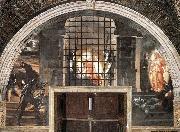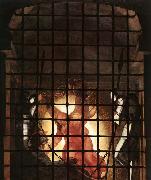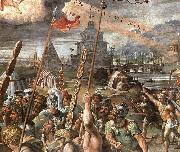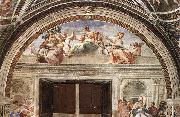RAFFAELLO Sanzio Huiler la Reproduction de TableauAll RAFFAELLO Sanzio Oil PaintingsItalian High Renaissance Painter, 1483-1520 |
|||

|
|||
|
|
|||
|
||||||||||||
| RAFFAELLO Sanzio Italian High Renaissance Painter, 1483-1520 |
||||||||||||
|
|
||||||||||||
| ID de tableau:: 63805 The Liberation of St Peter The Liberation of St Peter 1514 Fresco, width at base 660 cm Stanza di Eliodoro, Palazzi Pontifici, Vatican The story in the New Testament says that King Herod took Peter prisoner and intended to have him killed. In prison the Apostle was chained to two guards, but an angel of the Lord freed him despite the close watch. The fresco is dated 1514 on two painted tablets in the picture. The composition of this fresco clearly reflects the order and unity of the Mass of Bolsena. But the story is broken down into three distinct episodes, taken from the Acts of the Apostles. The first shows the dismay of the guards; the second the appearance of the Angel of Freedom in the saint's cell; the third, the bewildered Peter led by the hand of the divine messenger. The barred cell is on an upper level (like the altar in the Mass) and is reached by steps to the left and right. A group of agitated figures occupies the stairway at the left. Here, a soldier - whose armor reflects the light of the moon asks his sleepy and bewildered comrades what is going on. At right, the angel leads the stunned and still-sleepy St Peter past another sleeping guard. Here, for the first time, Raphael attempts a "night effect", using both the natural light of the moon and the autonomous light of the angel. Raphael's assistants played a greater role in painting the Eliodoro cycle than in the Stanza della Segnatura. This is clearly a consequence of the growing number of commissions which the Romans granted to Raphael. The hand of Giulio Romano, one of his most faithful pupils, is visible in the episode showing the Liberation of St Peter. This painting is the last fresco that can be attributed to Raphael with any certainty. The large cycles which follow (except for the Sibyls of Santa Maria della Pace) were entrusted mainly to assistants.Artist:RAFFAELLO Sanzio Title: The Liberation of St Peter Painted in 1501-1550 , Italian - - painting : religious 1514 Fresco, width at base 660 cm Stanza di Eliodoro, Palazzi Pontifici, Vatican The story in the New Testament says that King Herod took Peter prisoner and intended to have him killed. In prison the Apostle was chained to two guards, but an angel of the Lord freed him despite the close watch. The fresco is dated 1514 on two painted tablets in the picture. The composition of this fresco clearly reflects the order and unity of the Mass of Bolsena. But the story is broken down into three distinct episodes, taken from the Acts of the Apostles. The first shows the dismay of the guards; the second the appearance of the Angel of Freedom in the saint's cell; the third, the bewildered Peter led by the hand of the divine messenger. The barred cell is on an upper level (like the altar in the Mass) and is reached by steps to the left and right. A group of agitated figures occupies the stairway at the left. Here, a soldier - whose armor reflects the light of the moon asks his sleepy and bewildered comrades what is going on. At right, the angel leads the stunned and still-sleepy St Peter past another sleeping guard. Here, for the first time, Raphael attempts a "night effect", using both the natural light of the moon and the autonomous light of the angel. Raphael's assistants played a greater role in painting the Eliodoro cycle than in the Stanza della Segnatura. This is clearly a consequence of the growing number of commissions which the Romans granted to Raphael. The hand of Giulio Romano, one of his most faithful pupils, is visible in the episode showing the Liberation of St Peter. This painting is the last fresco that can be attributed to Raphael with any certainty. The large cycles which follow (except for the Sibyls of Santa Maria della Pace) were entrusted mainly to assistants.Artist:RAFFAELLO Sanzio Title: The Liberation of St Peter Painted in 1501-1550 , Italian - - painting : religious |
||||||||||||
|
|
||||||||||||
| ID de tableau:: 63806 The Liberation of St Peter The Liberation of St Peter 1514 Fresco, width of detail: 235 cm Stanza di Eliodoro, Palazzi Pontifici, Vatican The story in this fresco is broken down into three distinct episodes, taken from the Acts of the Apostles. The second (in the centre) shows the appearance of the Angel of Freedom in the saint's cell.Artist:RAFFAELLO Sanzio Title: The Liberation of St Peter (detail) Painted in 1501-1550 , Italian - - painting : religious 1514 Fresco, width of detail: 235 cm Stanza di Eliodoro, Palazzi Pontifici, Vatican The story in this fresco is broken down into three distinct episodes, taken from the Acts of the Apostles. The second (in the centre) shows the appearance of the Angel of Freedom in the saint's cell.Artist:RAFFAELLO Sanzio Title: The Liberation of St Peter (detail) Painted in 1501-1550 , Italian - - painting : religious |
||||||||||||
|
|
||||||||||||
| ID de tableau:: 63807 Vision of the Cross Vision of the Cross 1520-24 Fresco Stanza di Constantino, Palazzi Pontifici, Vatican The view of the "Tomb-pyramid of Romulus", which is no longer there, and the so-called Citadel of Sant'Angelo together with the bridge of Sant'Angelo, is an example of Raphael's interest in ancient Rome. The view Raphael has chosen more or less matches the view he had of Rome in 1520 from his Vatican loggie, which are located right behind the wall painted with the fresco. The Citadel of Sant'Angelo appears to be Raphael's reconstruction of the original ancient building, the erstwhile Hadrian Mausoleum, as it might have looked in the days of Emperor Constantine. By depicting this view of ancient Rome, Raphael is suggesting to anyone viewing that fresco that Constantine experienced his vision in the precise place where the Vatican State is now located. By this means Raphael was able to confirm in a very subtle manner, that the Popes had established themselves in Rome - more specifically - in the Vatican.Artist:RAFFAELLO Sanzio Title: Vision of the Cross (detail) Painted in 1501-1550 , Italian - - painting : historical 1520-24 Fresco Stanza di Constantino, Palazzi Pontifici, Vatican The view of the "Tomb-pyramid of Romulus", which is no longer there, and the so-called Citadel of Sant'Angelo together with the bridge of Sant'Angelo, is an example of Raphael's interest in ancient Rome. The view Raphael has chosen more or less matches the view he had of Rome in 1520 from his Vatican loggie, which are located right behind the wall painted with the fresco. The Citadel of Sant'Angelo appears to be Raphael's reconstruction of the original ancient building, the erstwhile Hadrian Mausoleum, as it might have looked in the days of Emperor Constantine. By depicting this view of ancient Rome, Raphael is suggesting to anyone viewing that fresco that Constantine experienced his vision in the precise place where the Vatican State is now located. By this means Raphael was able to confirm in a very subtle manner, that the Popes had established themselves in Rome - more specifically - in the Vatican.Artist:RAFFAELLO Sanzio Title: Vision of the Cross (detail) Painted in 1501-1550 , Italian - - painting : historical |
||||||||||||
|
|
||||||||||||
| ID de tableau:: 63808 The Cardinal Virtues The Cardinal Virtues 1511 Fresco, width at the base 660 cm Stanza della Segnatura, Palazzi Pontifici, Vatican The lunette above the scenes Justinian Presenting the Pandects to Trebonianus (left) and Gregory IX Approving the Decretals (right) represents the Cardinal Virtues. Fortitude can be recognized by her attribute, the lion; Wisdom, who has two faces, by her mirror; and Temperance by the reins. Fortitude is holding an oak branch, a reference to the pope's family name, Rovere, meaning "oak."Artist:RAFFAELLO Sanzio Title: The Cardinal Virtues Painted in 1501-1550 , Italian - - painting : religious 1511 Fresco, width at the base 660 cm Stanza della Segnatura, Palazzi Pontifici, Vatican The lunette above the scenes Justinian Presenting the Pandects to Trebonianus (left) and Gregory IX Approving the Decretals (right) represents the Cardinal Virtues. Fortitude can be recognized by her attribute, the lion; Wisdom, who has two faces, by her mirror; and Temperance by the reins. Fortitude is holding an oak branch, a reference to the pope's family name, Rovere, meaning "oak."Artist:RAFFAELLO Sanzio Title: The Cardinal Virtues Painted in 1501-1550 , Italian - - painting : religious |
||||||||||||
|
|
||||||||||||
| ID de tableau:: 63809 Ceiling Ceiling 1513-14 Fresco Stanza di Eliodoro, Palazzi Pontifici, Vatican The four great paintings on the ceiling show scenes from the Old Testament, the theme being God's intervention at a critical moment in Man's destiny: Moses and the Burning Bush is above the fresco The Expulsion of Heliodorus; Isaac's Sacrifice of his Son is above The Mass at Bolsena; Noah's Dream is above The Meeting between Leo the Great and Attila; and Jacob's Ladder is above The Liberation of St Peter.Artist:RAFFAELLO Sanzio Title: Ceiling Painted in 1501-1550 , Italian - - painting : religious 1513-14 Fresco Stanza di Eliodoro, Palazzi Pontifici, Vatican The four great paintings on the ceiling show scenes from the Old Testament, the theme being God's intervention at a critical moment in Man's destiny: Moses and the Burning Bush is above the fresco The Expulsion of Heliodorus; Isaac's Sacrifice of his Son is above The Mass at Bolsena; Noah's Dream is above The Meeting between Leo the Great and Attila; and Jacob's Ladder is above The Liberation of St Peter.Artist:RAFFAELLO Sanzio Title: Ceiling Painted in 1501-1550 , Italian - - painting : religious |
||||||||||||
|
|
||||||||||||
| Artiste précédent Artiste prochain | ||||||||||||
|
|
||||||||||||
|
RAFFAELLO Sanzio Italian High Renaissance Painter, 1483-1520 |
||||||||||||
|
|
||||||||||||
|
CONTACTER DES Etats-Unis |










